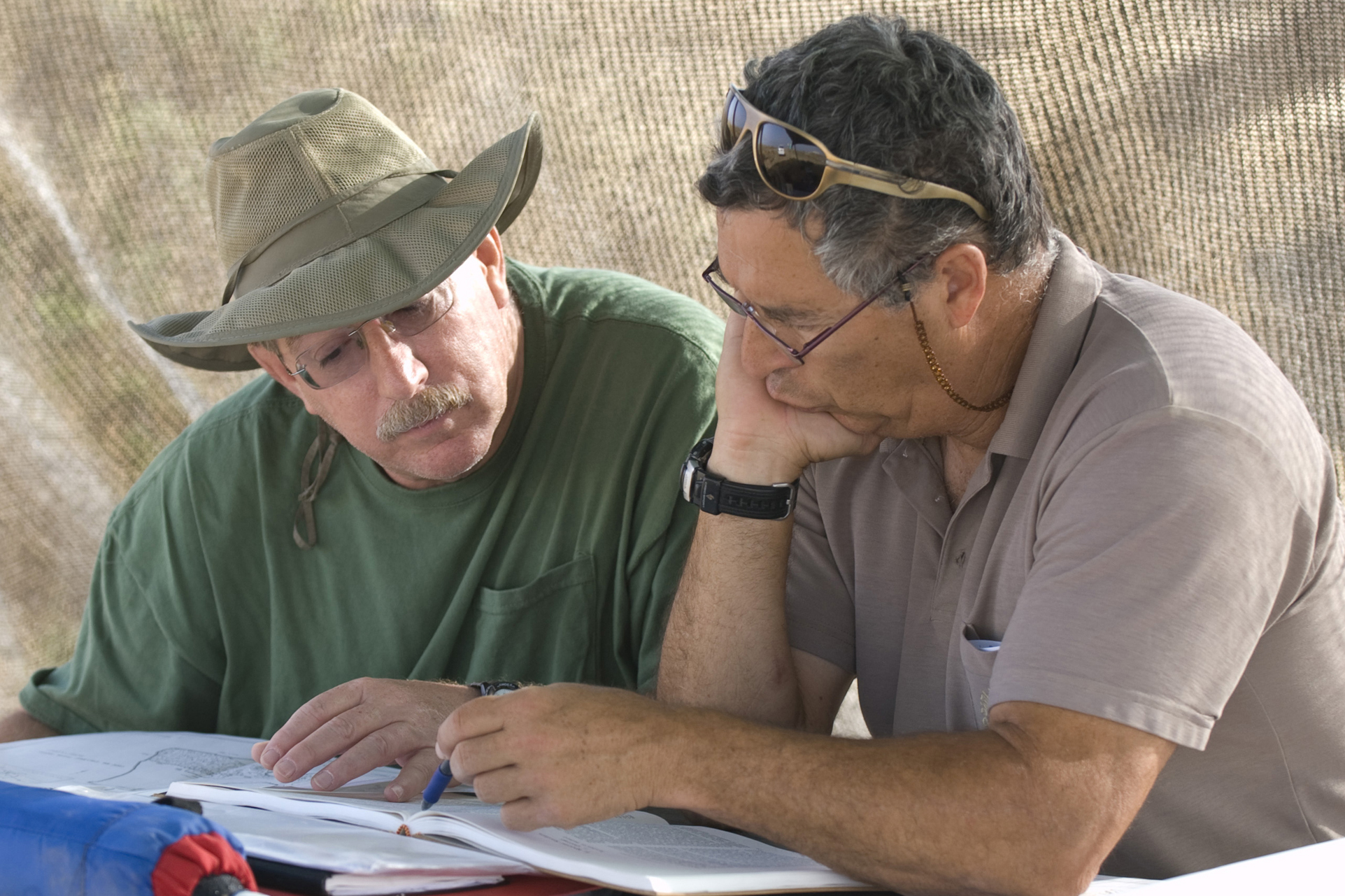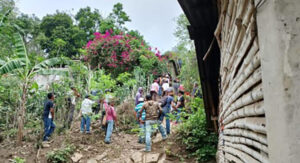
EDITOR’S NOTE: A second story about the archeological dig at Gezer, Israel, follows below this story from New Orleans Baptist Theological Seminary.
GEZER, Israel (BP)–An archeological team from New Orleans Baptist Theological Seminary has uncovered a natural cave at the end of a Canaanite water system in Israel, shedding light on an Old Testament culture.
The Gezer Water System Expedition, about 20 miles west of Jerusalem, is a joint project of NOBTS and the Israel Nature and Parks Authority. Dan Warner, associate professor of Old Testament and archaeology at NOBTS, and Tsvika Tsuk of INPA are directing the excavation of the ancient Tel Gezer water system, which dates as early as 1800 B.C.
“The research at Gezer is important to Baptists because of our commitment to understand the Bible within its historical context,” Warner said. “Any information we can gain to give better insights into the cultures of the biblical world helps us interpret the Bible.
“Most think of the Canaanites as an old, rustic culture — not so,” Warner noted. “Digging the water system took great technical and hydraulic skill. This was a very advanced and sophisticated culture that had pronounced impact in biblical times.”
It is believed the Canaanites cut the massive tunnel around the time of Abraham using flint tools. Measuring nearly 13 feet wide by 24 feet high at the opening and stretching 150 feet into the ground at a 38 degree slope, the Gezer tunnel is the largest ancient water system ever unearthed.
Late in the last week of the 2011 dig, the NOBTS team found the natural cave at the end of the massive rock-hewn water system — the prime objective of this season’s dig. It is believed that the system’s original water source is located in or near the opening of the cave.
The excavation, which removed 230 tons of dirt this summer, created quite a stir within the Israeli archaeological community. Numerous archaeological dignitaries made their way to Gezer to tour the site this year. Ronny Reich and Eli Shukron, two archaeologists who wrote an influential article on the subject in 2003, were among the guests. Sam Wolff and others from the Israel Antiquities Authority also visited the site. The NOBTS team encompassed the work of 33 people at different times during the summer.
The buzz has continued in the United States. In October, Warner will present his research at the Oklahoma Water Research Symposium and Governor’s Water Conference, and in November, he will give lectures at the Near Eastern Archaeological Society and American Schools of Oriental Research meetings in San Francisco.
NOBTS professors Dennis Cole, Jim Parker and Harold Mosley also are involved with the dig. Cole and Warner co-direct the Center for Archaeological Research at New Orleans Seminary.
The water system and the cave were discovered more than a century ago by Irish archaeologist R.A.S. Macalister during his excavation at Gezer from 1906-08. French archaeologist Pére L.H. Vincent visited the water system and the cave during Macalister’s excavation. Neither archaeologist fully excavated the cave, and they offered conflicting descriptions of the cave and water system.
During next summer’s dig, scheduled for May 27-June 15, the New Orleans team will focus on excavating the cave in hopes of answering several lingering questions about the water system. First and foremost, the team will try to discover how the Canaanites knew about the water source. Warner believes the Canaanites found the water source through an opening in the cave located outside the city walls. He speculates that the tunnel was cut to provide the city with a safe water source during times of siege.
“The tunnel is cut perfectly straight, and it’s very artistic. You don’t cut something like that blindly,” Warner said. “You have to know water is down there. You just aren’t going to spend all that time and energy.”
Another question involves the date of the tunnel’s construction. Macalister, Tsuk, Warner and other archaeologists have proposed an early date for the system — during the Middle Bronze Age (between 1800 and 1500 B.C.) — making the Gezer tunnel one of the oldest rock-hewn water systems ever discovered.
Other scholars, including noted archaeologist William Dever, do not believe the system is that old. He has proposed a Late Bronze Age or Iron Age date for the tunnel. Warner remains hopeful that evidence can be found to settle the long-running debate over the date.
“We might get a better perspective [on the date] inside the cave,” Warner said. “There might be carvings on the wall or some type of inscription. There could be pottery remains, and if we find consistent pottery remains from the Middle and Late Bronze Age, that at least gives us a pretty good idea that it dates from the start of the Middle Bronze Age.”
In 2012, the team also will try to uncover the original water source which Macalister described as a “powerful spring of water.” Based on the muddy conditions in the cave, Warner thinks the spring may still be active.
While finding the cave was a major accomplishment, Warner said one of the significant outcomes of this year’s dig was gaining accurate measurements of the tunnel. Vincent’s measurements proved to be much more accurate than Macalister’s. Since Macalister and Vincent offered differing descriptions of the cave, setting the record straight will be a key component of the 2012 dig.
So far Macalister’s drawings and descriptions of the inside of the cave correspond better with what the dig team experienced this year, including a series of large flat stones near the mouth. Vincent shows a cave completely obstructed by large rounded rocks. He also indicates an exit at the end of the cave.
Macalister’s drawings do not show this opening. According to Parker, the NOBTS researchers hope to settle the matter of the possible exit. The team also will provide new measurements, descriptions, drawings and photographs of the cave’s interior.
–30–
Gary Myers is director of public relations for New Orleans Baptist Theological Seminary. For more information about New Orleans Seminary’s Center for Archaeological Research or to learn more about the 2012 dig, visit www.nobts.edu/ArchaeologyCenter or follow the blog at www.nobtsarchaeology.blogspot.com. Participation in the dig is open to the public. Interested individuals may contact Dennis Cole ([email protected]) or Dan Warner ([email protected]) for details.
Seminary innovates,
perseveres at Israel site
By Gary D. Myers
GEZER, Israel (BP)–To say that New Orleans Baptist Theological Seminary is engaged in a unique archaeological dig would be a colossal understatement. In many ways, its Gezer Water System excavation is a bit moving a mountain.
Traditional archaeology involves long hours of tedious work with a trowel, brush and a sifting screen. Small amounts of dirt are meticulously sifted to check for artifacts. Artifacts are carefully logged using time-honored scientific methods.
However: The Gezer Water System Expedition, a joint project of NOBTS and the Israel Nature and Parks Authority, requires a different, more physical approach in excavating an ancient water system that could date to the time of Abraham.
Because the massive tunnel, cut by the Canaanites by hand using flint tools, was excavated by Irish archaeologist R.A.S. Macalister from 1906-08, the New Orleans team did not sift the dirt during the first two dig seasons.
The massive water system measures 13 feet wide by 24 feet high and stretches 150 feet into the ground at a 38-degree angle. When NOBTS started the dig, nearly 65 percent of the tunnel was filled with dirt. During his dig 100 years ago, Macalister built a rock retaining wall to hold back the debris he removed. The wall, located near the mouth of the tunnel, collapsed after heavy rains in 1908 sending tons of rocks and dirt back into the water system. Over the years more dirt and debris has collected in the tunnel.
The process of clearing the tons of dirt, broken flint tools, pottery shards and rocks has been no easy task. It takes equal parts of innovation and determination for the excavation directed by Dan Warner, NOBTS associate professor of Old Testament and archaeology, and Tsvika Tsuk of the Israel Nature and Parks Authority.
For the 2010 dig season, NOBTS professor Jim Parker, a team member experienced as a coal miner and engineer, devised an excavation system which included large fabric bags and a crane. Three or four workers would shovel debris into the bags which hold more than 300 pounds of material each. The bags were pulled from the tunnel with the crane and dumped in a debris pile.
The system worked well for the first year of the dig, but Parker and Warner realized that innovation would be needed for 2011. The deeper the team progressed into the tunnel, the longer it took the crane to pull out the bags, creating a backlog that hampered progress.
Parker decided to add the winch near the mouth of the tunnel for the second dig season. The debris-filled bags were pulled to a staging area at the mouth of the tunnel by the winch. The winch decreased the lag time caused by the crane and proved to be an essential component in the team’s success.
Macalister and French archaeologist Pére Vincent, who visited the site during the original excavation, described a natural cave at the end of the water system. Warner and Parker believe the cave may help them determine how the Canaanites located the water source and when the tunnel was cut. Reaching the cave became the primary objective of this year’s dig.
To reach their goal, Warner and Parker recruited a much larger dig team than they had in 2010. Early on, the team encountered a major setback: several team members contracted the flu. As the sickness sidelined some, the rest of the team worked long days removing as much as 16 tons of material per day. The sickness continued to affect the team well into the second week of the dig.
The physically demanding work was intensified by the conflicting information about the water tunnel in the writings of Macalister and Vincent. Based on Macalister’s descriptions and the first week’s progress, Warner and Parker believed the team would reach the cave between June 1 and 3. The team kept a steady pace, removing 80 to 100 bags of debris per day, and passed Macalister’s measurement on June 2, but still no cave. After two more days of digging the team was discouraged.
On June 5, the team encountered the most difficult digging of the season. The bottom of the tunnel was packed with rocks believed to be part of Macalister’s collapsed retaining wall. Warner and Parker had expected to find portions of the wall near the opening of the cave. For them, the rocks were a good sign.
After slowly digging through the rocks for a day and a half, the team reached the cave on June 7. It was 15 feet deeper into the water system than Macalister had recorded. The cave was filled to the top with fine, muddy silt. The last two days of the dig were spent cutting a 3-foot by 17-foot trench into the cave silt, readying the site for the 2012 dig.
The final statistics from this summer are helpful in understanding the massive scope of the dig. According to Parker’s calculations, the team removed 231 tons of debris (1,372 bags) in 17 days of digging. Warner and Parker’s smaller 2010 team removed 68 tons of debris.
The NOBTS team is clearing the entire width of the tunnel, but only about 8 feet of the height. The other material did not need to be removed for Warner to research the natural cave. The layer of dirt also helped protect the hand-carved steps on the floor of the water system.
The INPA likely will clear out the remaining debris from the tunnel and develop the water system as a tourist attraction. According to Parker’s estimates, the remaining debris could top out around 860 tons.
The 2012 dig, set for May 27 through June 15, will focus on clearing the cave and will involve a more traditional archaeological approach. Neither Macalister nor Vincent completely excavated the cave, so Warner and Parker believe that it may hold ancient artifacts.
–30–















